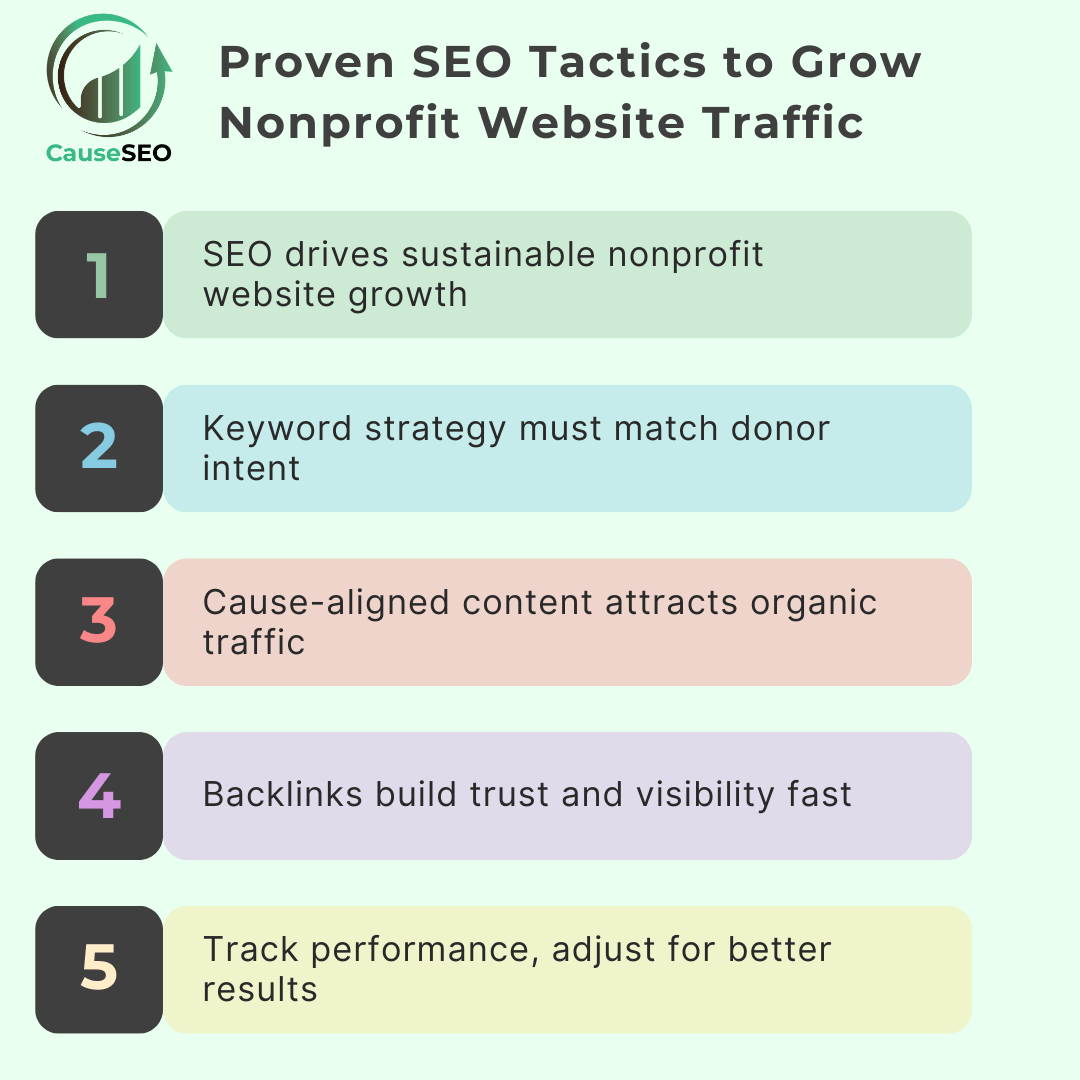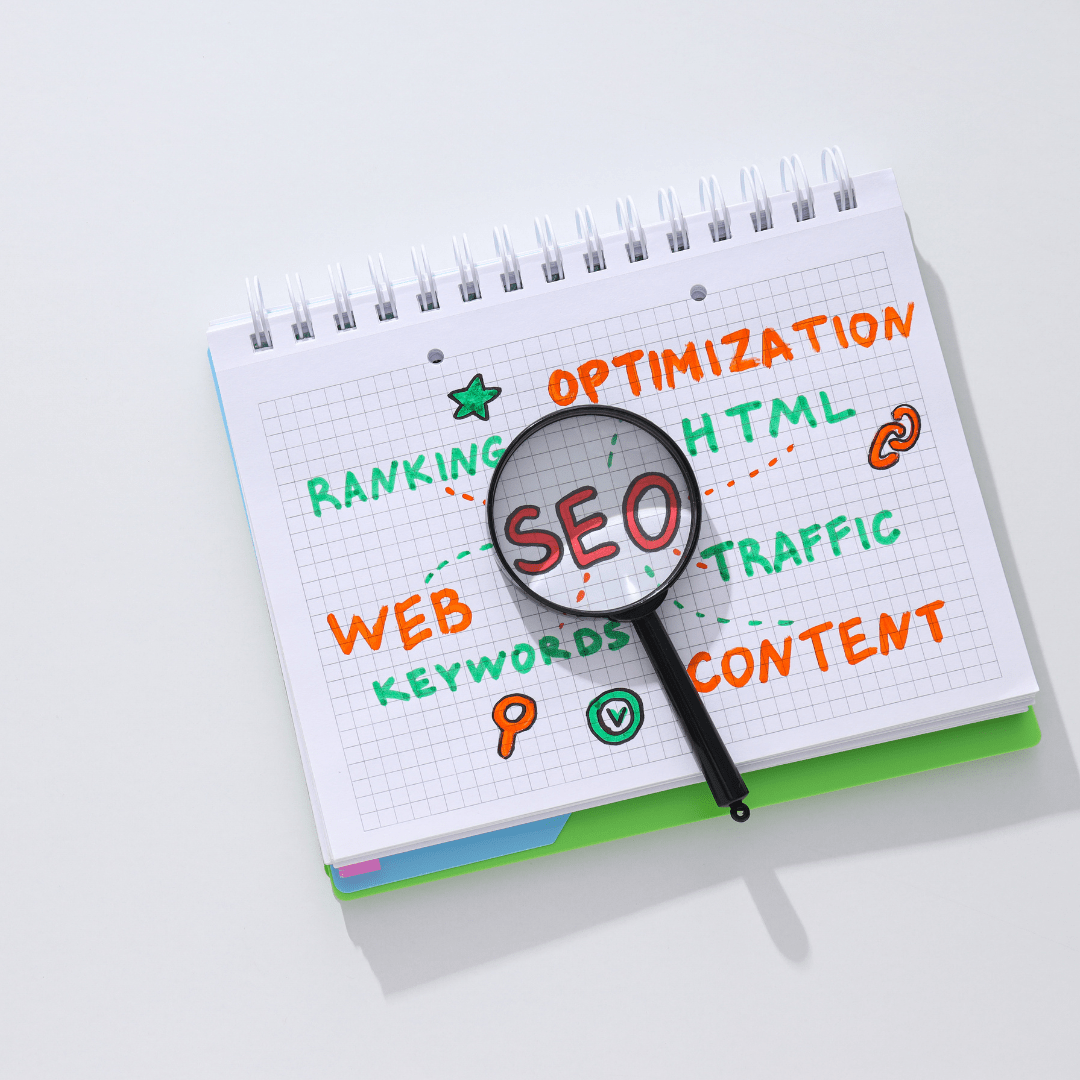Ever wonder why your nonprofit website barely gets seen—despite all the good work you’re doing? You’re not alone. Most organizations struggle with visibility online, and that means missed donations, fewer volunteers, and lost opportunities. To grow nonprofit website traffic, you need more than just social media posts and hope—you need a clear strategy rooted in SEO.
SEO for nonprofits isn’t about chasing clicks. It’s about showing up when someone searches “donate to food banks” or “volunteer near me.” That visibility translates into action—from more donors to greater awareness.
This guide skips the fluff. Instead, you’ll get proven SEO tactics your nonprofit can implement now to attract meaningful traffic and grow your mission online.

Why SEO Is Essential for Nonprofit Growth
The Traffic Problem Most Nonprofits Face
Many nonprofit websites suffer from one core issue: people aren’t finding them. That’s often because of weak keyword targeting, confusing site structure, or overreliance on platforms like Instagram or Facebook. Social media is great, but it’s not sustainable on its own.
Others pour money into Google Ads without a long-term plan. As soon as the budget dries up, so does the traffic. That cycle isn’t built for lasting visibility.
How SEO Solves It
SEO flips the script. Instead of paying for attention, you earn it. By showing up in search results when people are actively looking to engage, donate, or volunteer, you build momentum that lasts. Plus, SEO for charities helps you attract people who truly care about your mission—not just those scrolling by.
Tactic #1 – Keyword Research That Matches Mission & Intent
Focus on Donor and Volunteer Search Intent
Let’s be clear: the people you want to reach are already searching. You just need to know what they’re typing. Think like your ideal supporter.
Are they looking for “how to support refugee families”? Or maybe “animal shelters that need help in Calgary”? These are the phrases your content should be targeting.
Tools and Strategy
You don’t need fancy tools, but they help. Try:
- Google Keyword Planner (free with an ad account)
- Ubersuggest
- SEMrush or Ahrefs (for deeper research)
Also, spy on what similar charities rank for. Check questions on Reddit, Quora, or Google’s “People Also Ask” section—this gives insight into real searches.
Avoid Generic Keywords
It’s tempting to aim for broad terms like “help children” or “charity organization,” but they’re too vague and competitive. Instead, go long-tail: “charities that help with school supplies in Winnipeg” is more likely to rank—and convert.
Tactic #2 – Optimize Pages That Matter Most
Start With High-Impact Pages
Not every page needs optimizing right away. Start where it counts:
- Donation Page
- About Us
- Mission Statement
- Key Programs
These are where people take action. Make them shine.
On-Page SEO Essentials
For each of these pages:
- Use one primary keyword (like “SEO for nonprofit organizations and charities”)
- Add that keyword to the title tag, H1, and meta description
- Use headers (H2s and H3s) to break up content
- Include internal links to relevant pages
- Add emotional but clear CTAs: “Help us plant 10,000 trees this year. Donate now.”

Tactic #3 – Content That Brings Traffic
Create Cause-Aligned Blog Topics
Blogging isn’t dead—it just needs direction. Write posts that connect to your mission and serve searcher needs:
- “How your donation helps rebuild schools”
- “Volunteer opportunities in Toronto this summer”
- “Why access to clean water changes everything”
Evergreen + Timely Posts
Mix long-lasting content (e.g. “how to sponsor a child”) with seasonal content (“how to help during winter holidays”). This creates a steady stream of new and consistent visitors.
Optimize for Featured Snippets & Search Questions
Use question-based headers like:
- “How can I support animal rescue?”
- “Why should I donate to small charities?”
Answer clearly and quickly. Use bullet points. Add FAQs. Google rewards content that solves problems fast.
Tactic #4 – Build Backlinks from Trusted Sources
Partner with Local News, Sponsors, Other Nonprofits
Backlinks are votes of confidence. The more reputable sites that link to you, the better. Pitch story ideas to journalists. Collaborate on content with partners. Co-host an event and share press releases across all platforms.
Create Link-Worthy Assets
Data-rich reports, impact stats, or downloadable toolkits tied to your cause tend to earn backlinks. Example: a climate nonprofit could publish a “2025 Urban Green Report” that local blogs and news outlets reference.
Tactic #5 – Use Local SEO to Drive Community Engagement
Google Business Profile Setup
If your nonprofit has a physical presence, claim your Google Business Profile. Add your hours, phone number, location, and photos. Keep it updated.
Location-Based Content
Write pages or posts like:
- “How we’re helping families in Winnipeg”
- “Join our Vancouver food drive this October”
These not only rank locally but also show commitment to the community.
NAP Consistency & Local Citations
Make sure your Name, Address, and Phone number match across every directory (Google, Bing, Yelp, etc.). This builds trust with both search engines and users.
Tactic #6 – Track, Measure, and Adjust
Set Up Google Analytics and Search Console
You can’t improve what you don’t track. These free tools show how people find you, where they bounce, and what actions they take. Key metrics to watch:
- Organic traffic
- Bounce rate
- Click-through rate
- Conversions (donations, signups)
Audit Performance Monthly
Check what’s ranking. If a blog post starts slipping, update it. If another climbs the ranks, build on that topic. SEO is never set-and-forget.

Common SEO Mistakes Nonprofits Should Avoid
Mistake 1 – Ignoring Mobile Optimization
Most users come via phone. If your site isn’t mobile-friendly, they’ll bounce—and Google notices.
Mistake 2 – Neglecting Internal Linking
Every page should link to other relevant ones. It helps users and search engines understand your structure.
Mistake 3 – Publishing Without Promotion or Optimization
Don’t just hit publish. Share your content in newsletters, on social media, and optimize for keywords from day one.
FAQs – SEO for Nonprofit Website Traffic
How long does it take to see traffic results from SEO?
Typically, 3–6 months for noticeable growth—longer for competitive topics.
Do we need a blog to grow organic traffic?
It helps a lot. Blogs allow you to target new keywords, share stories, and provide fresh content for Google.
Can we do SEO ourselves or should we hire an expert?
You can start small. But if you’re serious about growing traffic, consider working with a search engine optimization consultant or a charity marketing agency like CauseSEO.com.
Is local SEO important for all nonprofits?
If you serve a specific area, yes. Local SEO helps you show up in maps, searches, and community events.
What’s the difference between SEO and Google Ads?
Google Ads are paid and short-term. SEO builds lasting, free traffic—but takes time.
Conclusion: SEO Is How Nonprofits Grow
SEO is not just a marketing tool—it’s a growth engine. For charities and nonprofits that want to be seen, supported, and sustained, search engine optimization is essential.
CauseSEO specializes in helping nonprofits get found online. From keyword strategy to full SEO audits, our team knows how to grow your impact—without wasting your budget.
Contact us today for a free SEO audit or a custom plan built just for your mission.

